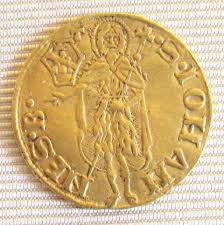By the 13th century, Europe was experiencing an economic transformation. The Crusades had reopened trade routes with the Middle East and North Africa, and gold was once again flowing into Europe. The influence of Middle Eastern gold coins, particularly the Islamic dinar, led European states to recognize the need for a stable gold currency to facilitate long-distance trade.
In response, two of medieval Europe’s most powerful commercial centers—Florence and Venice—introduced the first widely accepted European gold coins:
- The Florin (1252, Florence)
- The Ducat (1284, Venice)
These coins would dominate European trade for centuries, laying the foundation for modern financial systems.

The Florin (1252) – Florence’s Gold Revolution
A. The Introduction of the Florin
In 1252, the Republic of Florence minted the gold florin, the first major European gold coin since the fall of the Western Roman Empire. Unlike earlier attempts at gold coinage, the florin was:
✅ Standardized – Weighed 3.5 grams of pure gold.
✅ Highly Trusted – Maintained a consistent gold content, avoiding debasement.
✅ Widely Used – Quickly accepted across Europe, the Middle East, and North Africa.
B. The Impact of the Florin on European Trade
- Banking & Finance – The florin became the standard currency for international banking, used by major financial families like the Medici.
- Long-Distance Commerce – Merchants across Europe and the Mediterranean used florins for trade with the Islamic world and Byzantium.
- Government & Taxation – Many European kingdoms collected taxes and paid armies in florins due to their stability.
The florin’s success inspired other states to issue their own gold coins, marking a turning point in European monetary history.
The Ducat (1284) – Venice’s Gold Standard
A. Why Venice Introduced the Ducat
By the late 13th century, Venice had become one of Europe’s leading trade powers, controlling key routes across the Mediterranean and Black Sea. The Venetian Republic saw the success of the Florentine florin and decided to issue its own gold currency to strengthen its position in global trade.
In 1284, Venice introduced the gold ducat, which would become one of the most influential coins in history.
B. The Features of the Ducat
- Weight & Purity – The ducat contained 3.5 grams of nearly pure gold (99.47%), making it one of the most trusted coins.
- Design – It featured Saint Mark and the Doge of Venice, reinforcing Venice’s political and economic power.
- Adoption Across Europe – The ducat quickly became the preferred currency of merchants and bankers, surpassing even the florin in some regions.
C. The Ducat’s Role in International Trade
- Used from Europe to the Ottoman Empire – The ducat was accepted across the Mediterranean, North Africa, and the Middle East.
- Financed Wars & Empires – European kingdoms used ducats for military campaigns, trade deals, and taxation.
- Became the Model for Later Gold Coins – The ducat’s success influenced gold currencies in Spain, France, and Germany.
Conclusion: The Legacy of the Florin & Ducat
The introduction of the gold florin and ducat in the 13th century marked the full return of gold coinage to Europe. These coins:
✅ Revived a gold-based economy, replacing silver as the dominant currency for international trade.
✅ Created a standard for financial transactions, influencing banking, taxation, and commerce.
✅ Remained in use for centuries, with the ducat lasting into the 19th century as an international currency.
The success of these coins proved that Europe was ready to compete with the Middle Eastern and Byzantine monetary systems, paving the way for the financial expansion of the Renaissance and Age of Exploration.
